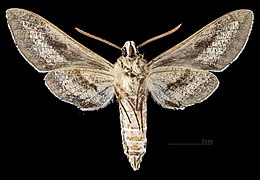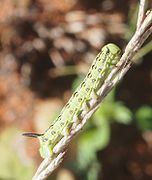Hyles livornicoides
| Hyles livornicoides | |
|---|---|

| |
| Scientific classification | |
| Domain: | Eukaryota |
| Kingdom: | Animalia |
| Phylum: | Arthropoda |
| Class: | Insecta |
| Order: | Lepidoptera |
| Family: | Sphingidae |
| Genus: | Hyles |
| Species: | H. livornicoides
|
| Binomial name | |
| Hyles livornicoides (Lucas, 1892)[1]
| |
| Synonyms | |
| |
Hyles livornicoides, the Australian striped hawk moth, is a moth of the family Sphingidae first described by Lucas in 1892. The larvae are known by the common name Yeperenye caterpillar, in the Arrernte language the caterpillars are referred to as Ayepe-arenye.
Distribution[edit]
It is found in Australia in New South Wales, the Northern Territory, Queensland, Victoria and Western Australia.
Description[edit]
The wingspan is about 60 mm.
-
Male dorsal view
-
Male ventral view
-
Caterpillar
Biology[edit]
The larvae feed on Portulaca oleracea, Boerhavia diffusa, Boerhavia schomburgkiana, Vitis vinifera and Tribulus terrestris. They are gregarious and live in dense colonies.
Human interactions[edit]
H. livornicoides was considered by the Arrernte people to be the most important ancestral being, along with the Ntyarlke and Utnerrengatye caterpillars. The caterpillar in the Arrernte language is known as Ayepe-arenye, referring to the ayepe (tar-vine) that they feed on.[2]
The larvae were used as food by Aborigines. They starved the caterpillars for a day or two before roasting them in hot ashes. Due to their sacred nature, following decapitation, their entrails were removed and buried in a hole.[3] The cooked larvae were said to have a pleasant savoury taste and could be stored for a long time.
References[edit]
- ^ "Sphingidae Taxonomic Inventory: Hyles livornicoides". sphingidae.myspecies.info. Retrieved 24 June 2023.
- ^ Walsh, Fiona (13 February 2017). "Box BIO11 Caterpillars as big as a mountain: the role of spiritual beliefs about animals and plants". Australia State of the Environment Report. Archived from the original on 6 October 2019. Retrieved 13 August 2021.
- ^ Sleath, Emma. "Sacred caterpillars plentiful after the rain - ABC (none) - Australian Broadcasting Corporation". Australian Broadcasting Corporation. Retrieved 13 August 2021.
External links[edit]
- Australian Faunal Directory
- Herbison-Evans, Don & Crossley, Stella (6 April 2016). "Hyles livornicoides (T.P. Lucas, 1892) Australian Striped Hawk Moth". Australian Caterpillars and their Butterflies and Moths. Retrieved 23 November 2018.
- "CATE Creating a Taxonomic eScience – Sphingidae". Cate-sphingidae.org. Archived from the original on 20 December 2012. Retrieved 25 October 2011.



